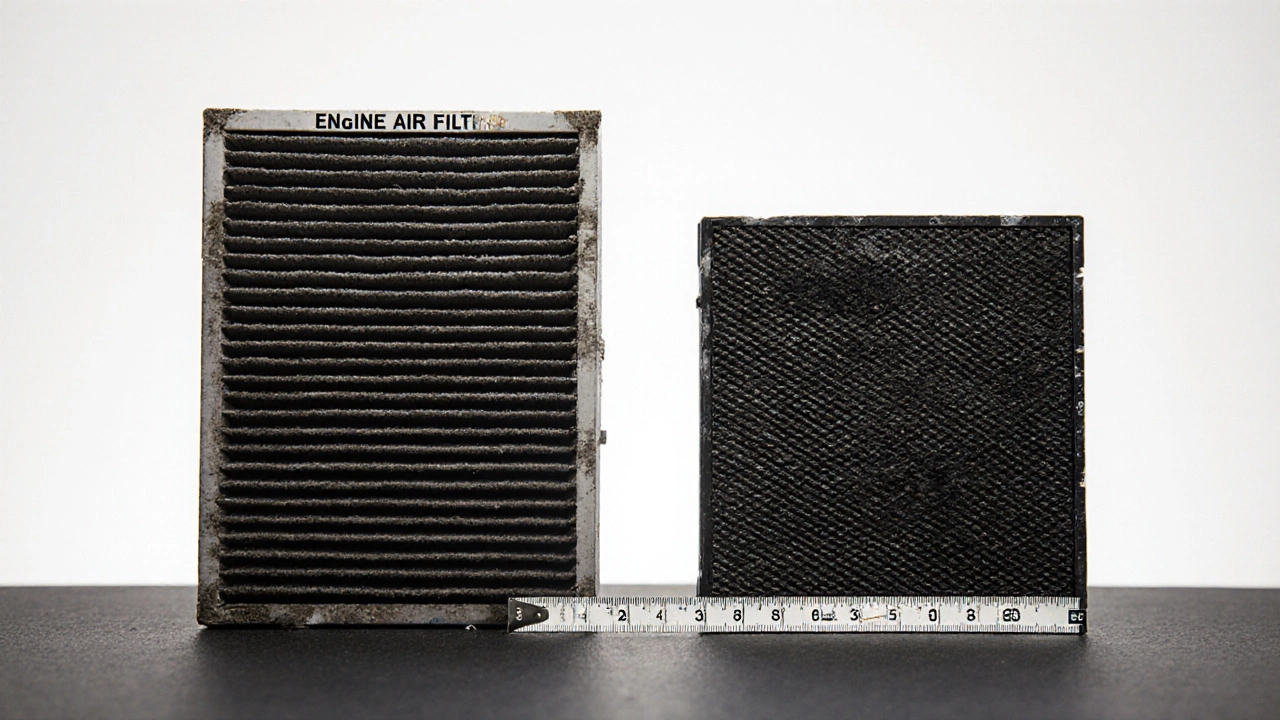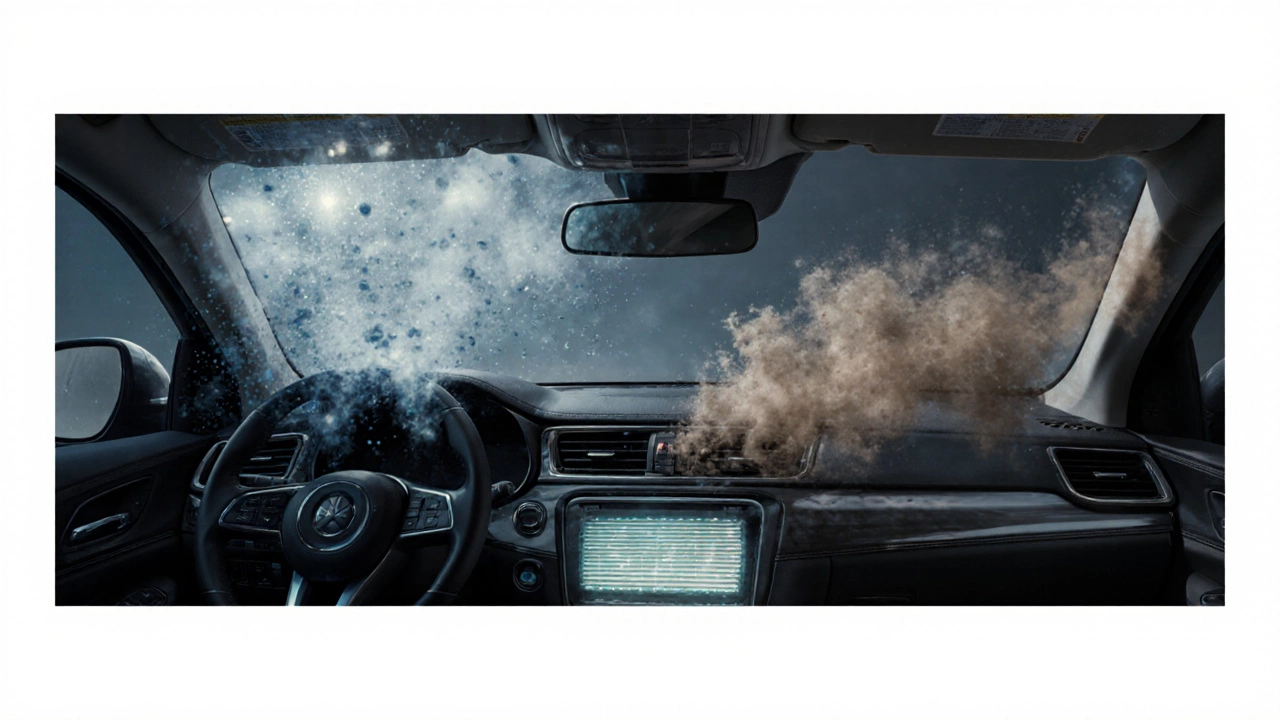Car AC Filter Finder
Find the exact cabin air filter for your car. This tool helps you identify the correct filter type and part number based on your vehicle information.
Enter Your Vehicle Details
Important: Always verify with your owner's manual or VIN for exact specifications. This tool provides general guidance only.
Your Recommended Filter
Filter Type:
Part Number:
Replacement Interval:
Recommended Filter:
Note:
Ever opened your car’s hood and stared at the air filter, wondering which one to buy? You’re not alone. Many drivers replace their AC filter based on guesswork-only to end up with the wrong size, the wrong type, or worse, no filter at all. A mismatched filter doesn’t just hurt your car’s performance-it can make your cabin smell musty, reduce airflow, and even strain your AC compressor. The good news? Figuring out the right filter is simple if you know where to look.
Start with your owner’s manual
Your car’s owner’s manual is the first and best place to check. It doesn’t just tell you when to change the filter-it lists the exact part number and size. Look in the maintenance section, usually under "Engine Air Filter" or "Cabin Air Filter." Most manuals even include a diagram showing where the filter sits. If you’ve lost the manual, you can download a free digital copy from the manufacturer’s website by entering your car’s make, model, and year.For example, a 2021 Ford Focus uses a cabin air filter with part number CAF-1245. A 2019 Honda Civic uses CAF-987. These numbers are unique to each model. Never assume your neighbor’s filter fits your car-even if they’re the same make.
Know the difference: engine air filter vs. cabin air filter
There are two types of air filters in most cars, and they do completely different jobs.- Engine air filter: Keeps dirt, dust, and debris out of your engine. It’s usually under the hood in a black plastic box. If this one’s clogged, your engine loses power and fuel efficiency drops.
- Cabin air filter: Cleans the air that comes through your vents. It stops pollen, smog, and even mold spores from entering the cabin. If this one’s dirty, you’ll notice bad smells, weak airflow from the vents, or foggy windows faster than usual.
Many people confuse the two. If your AC isn’t blowing hard enough or the air smells like wet socks, it’s likely the cabin filter. If your engine feels sluggish or the check engine light flickers, check the engine filter. They’re not interchangeable. Always confirm which one you’re replacing.
Check the old filter
Before you buy a new one, take out the old filter. It’s usually held in place by clips, screws, or a plastic latch. Once you pull it out, you’ll see a label on the side with the size, part number, and sometimes even the brand.Write down the numbers. Take a photo. If the label’s faded, measure it. Use a tape measure to note the length, width, and thickness in millimeters. Most cabin filters are between 10mm and 25mm thick. Engine filters are larger-often 200mm x 150mm or bigger. Don’t guess. Even a 2mm difference can cause leaks or poor sealing.

Use your VIN to find the right part
Your Vehicle Identification Number (VIN) is a 17-character code that’s unique to your car. It’s on your registration, insurance card, or stamped on the driver’s side dashboard near the windshield. Enter it into any reputable auto parts website like AutoZone, Halfords, or Amazon’s vehicle-specific search tool. The system will pull up every filter that fits your exact model.This method works better than typing in "2020 Toyota Corolla air filter" because it accounts for trim levels, engine types, and factory options. A Corolla with a 1.8L engine might need a different filter than one with a hybrid powertrain. The VIN cuts through the confusion.
Don’t rely on price or brand alone
You’ll see filters priced from £5 to £30. A cheap filter isn’t always a bad one, but a £30 filter isn’t always better. What matters is the material and fit.- Standard paper filters: Basic, effective, and affordable. Good for everyday driving.
- Carbon-activated filters: Add charcoal to trap odors and gases. Great if you drive in heavy traffic or cities.
- Washable/reusable filters: Made of foam or cotton. You clean them every 12-24 months. They cost more upfront but save money long-term.
Brands like Mann-Filter, K&N, and Fram are reliable. But don’t assume a "premium" brand means better performance. Check reviews from UK drivers-especially those who live in Manchester or London, where pollution and damp conditions affect filter life.
When to replace it
Most manufacturers recommend replacing the cabin air filter every 12,000 to 15,000 miles-or once a year. But if you drive on dusty roads, near construction sites, or in rainy, leafy areas, check it every 6 months.Signs it’s time for a new one:
- Weak airflow from the vents, even on high speed
- Musty, moldy smell when you turn on the AC
- Foggy windows that won’t clear, even with the defroster on
- Allergies flare up during drives
Engine filters last longer-usually 15,000 to 30,000 miles. But if you drive in rural areas with gravel roads or during pollen season, inspect it every 10,000 miles. A clogged engine filter can cost you 10% in fuel economy.

How to install it (quick guide)
Replacing the filter is usually a 10-minute job. No tools needed for most cars.- Locate the filter housing (under the hood for engine filter, behind the glovebox for cabin filter).
- Open the clips or unscrew the cover.
- Remove the old filter. Note the airflow arrow-it points toward the engine or blower motor.
- Slide in the new filter with the arrow pointing the same way.
- Close the housing and snap the clips back in place.
Don’t force it. If the new filter doesn’t slide in easily, you have the wrong size. Return it and double-check your VIN or manual.
Common mistakes to avoid
- Buying by shape, not size-filters can look similar but have different thicknesses.
- Installing it backward-the airflow arrow must match the direction of airflow.
- Skipping the cabin filter-many people forget it exists until their nose starts hurting.
- Using a universal filter that doesn’t seal properly-leaks let unfiltered air into your system.
One UK driver in Sheffield told me he replaced his cabin filter every 6 months because he drives past a landfill. That’s extreme, but it shows how location matters. If you live near a busy road, industrial zone, or forest, your filter works harder.
What if I can’t find the right filter?
If you’ve checked the manual, measured the old one, used your VIN, and still can’t find a match, visit a local garage. Most UK garages have a digital parts catalog linked to manufacturers. They can pull up your car’s exact specs in seconds.Or call a parts supplier like Halfords or Euro Car Parts. Give them your registration number. They’ll find it. Don’t waste time ordering online if you’re unsure-you’ll end up with three wrong filters and a pile of returns.
And remember: a good filter isn’t expensive. A basic cabin filter costs less than a takeaway coffee. But a bad one can cost you in comfort, health, and fuel bills.
Can I drive without an AC filter?
Technically, yes-but you shouldn’t. Without an engine air filter, dirt enters your engine and scrapes the cylinder walls, leading to expensive repairs. Without a cabin filter, you breathe in dust, pollen, and exhaust fumes every time you drive. Neither is safe long-term.
Do all cars have a cabin air filter?
Most cars made after 2000 have one. Older models, especially basic trims from the 90s, might not. If your car has climate control or recirculation buttons, it likely has a cabin filter. Check your manual or ask a mechanic.
How often should I replace my cabin air filter?
Every 12,000 to 15,000 miles or once a year. If you drive in heavy traffic, near construction, or in a city like Manchester with high pollution, replace it every 6 months. Dirty filters reduce airflow and make your AC work harder, which can shorten its life.
Can I clean and reuse my air filter?
Only if it’s a reusable filter-usually made of foam or cotton. Standard paper filters can’t be cleaned. Washing them damages the fibers and lets dust through. Reusable filters cost more upfront but last 2-3 years with proper cleaning. Check the manufacturer’s instructions before attempting it.
What happens if I install the filter backward?
If the airflow arrow points the wrong way, the filter won’t seal properly. Air will bypass it, letting dust into your engine or cabin. You might notice reduced airflow, strange noises, or even a check engine light. Always match the arrow to the direction of airflow shown in your manual or on the old filter.

